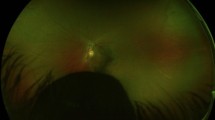Abstract
MH is a 73-year-old man who presented to his ophthalmologist with the complaint of reduced vision in his left eye over several months. Examination found visual acuity OD of 20/30 and OS of 20/50. Slit-lamp examination showed mild nuclear sclerosis in both lenses and a dense sectorial cortical cataract in the superior nasal quadrant of the left lens. The fundus could not be seen in this area due to the lens opacity.
You have full access to this open access chapter, Download chapter PDF
Similar content being viewed by others
Keywords
These keywords were added by machine and not by the authors. This process is experimental and the keywords may be updated as the learning algorithm improves.
MH is a 73-year-old man who presented to his ophthalmologist with the complaint of reduced vision in his left eye over several months. Examination found visual acuity OD of 20/30 and OS of 20/50. Slit-lamp examination showed mild nuclear sclerosis in both lenses and a dense sectorial cortical cataract in the superior nasal quadrant of the left lens. The fundus could not be seen in this area due to the lens opacity.
B-scan showed part of a very peripheral lesion in the vicinity of the superior nasal ciliary body. Immersion scanning confirmed the presence of a ciliary body mass most consistent with a malignant melanoma (Fig. 1). The patient was advised not to undergo cataract surgery because of the potential for disseminating tumor cells via surgical manipulation. It was elected to observe the tumor for growth with serial echography every 3–4 months.
Solid and cystic lesions of the ciliary body and iris may go undetected until discovered on a slit-lamp examination as a bulge in the iris. Transillumination can sometimes be helpful in this setting, but the results of this test are often equivocal. This area is best evaluated by an immersion
B-scan. The standard 10-MHz probe is adequate to image some of these lesions, but 20 or 50 MHz (UBM) better characterizes smaller ones.
Author information
Authors and Affiliations
Rights and permissions
Copyright information
© 2014 Springer Science+Business Media New York
About this chapter
Cite this chapter
Harrie, R.P., Kendall, C.J. (2014). Case Study 2 Ciliary Body Melanoma and Sector Cataract. In: Clinical Ophthalmic Echography. Springer, New York, NY. https://doi.org/10.1007/978-1-4614-7082-3_2
Download citation
DOI: https://doi.org/10.1007/978-1-4614-7082-3_2
Published:
Publisher Name: Springer, New York, NY
Print ISBN: 978-1-4614-7081-6
Online ISBN: 978-1-4614-7082-3
eBook Packages: MedicineMedicine (R0)





